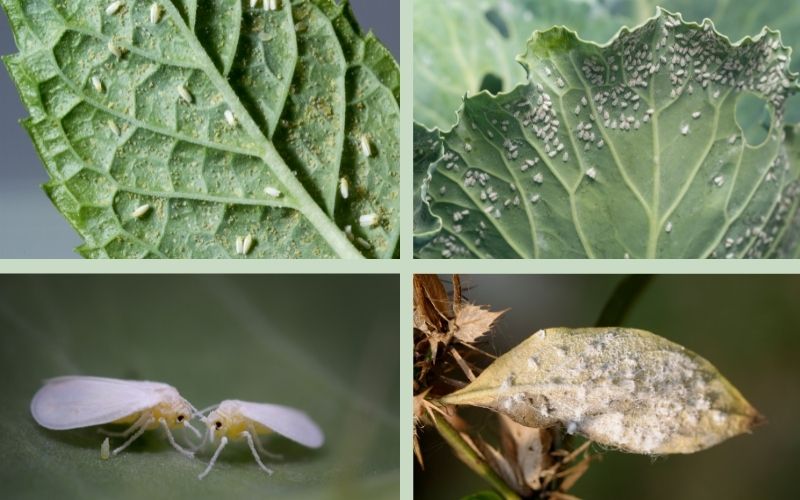1. Aphids

Vegetable plants affected: Most vegetable plants, especially the tender new growth.
Damage caused: Sucking sap from leaves and stems causes distortion and yellowing.
Methods of Control: Mechanical and biological control.
Find out more:
- Aphids on Vegetable Plants: How to Identify and Eradicate them
- The association between aphids and ants prevents aphid control
- Aphid mummies, mealybug mummies, and why they should never be disturbed!
2. Slugs and Snails

Plants affected: Mainly lettuce, cabbage, broccoli, and other leafy vegetables but can damage seedlings of all types of vegetable plants
Damage caused: Chewed irregular holes in the leaves and stems.
Methods of Control: Handpicking, beer traps, diatomaceous earth, and copper barriers.
Find out more: Slugs and snails can be good for your vegetable garden if kept under control
3. Cabbage Worms

Plants affected: Cabbage, broccoli, cauliflower, and other brassica vegetables.
Damage caused: Chewed leaves, resulting in holes and skeletonization.
Methods of Control: Handpicking, row covers (to stop the adult butterfly from laying eggs), companion planting, and biological control.
4. Tomato Hornworms

Plants affected: Tomatoes, peppers, and other plants in the nightshade family.
Damage caused: These caterpillars feed on leaves and fruit, and can completely devour the plant.
Methods of Control: Handpicking, Bt (Bacillus thuringiensis), and braconid wasps.
5. Cutworms
Plants affected: Young seedlings of various vegetables.
Damage caused: Cutting of stems at the soil level causes plants to wilt and die.
Methods of Control: Collars around seedlings, diatomaceous earth, and beneficial nematodes.
6. Flea Beetles
Plants affected: Cabbage, radish, eggplant, and other vegetables.
Damage caused: Feeding on leaves results in small holes and pits.
Methods of Control: Row covers and diatomaceous earth.
7. Colorado Potato Beetles

Plants affected: Potatoes, tomatoes, and eggplants.
Damage caused: Stripping off of foliage leads to reduced growth and yield.
Methods of Control: Handpicking, floating row covers, and biological control.
8. Squash Bugs
Plants affected: Squash, pumpkin, and other cucurbits.
Damage caused: Sucking of sap from leaves causes wilting and yellowing of leaves.
Methods of Control: Handpicking and diatomaceous earth.
9. Cucumber Beetles
Plants affected: Cucumbers, melons, and other cucurbits.
Damage caused: Feeding on leaves and transmitting bacterial diseases.
Methods of Control: Floating row covers and trap crops.
10. Whiteflies

Plants affected: Tomatoes, peppers, and other vegetables grown in a greenhouse or in warm weather.
Damage caused: Sucking sap and causing yellowing and sooty mold.
Methods of Control: Mechanical removal, biological control, and diatomaceous earth.
Find out more: What are the little white bugs flying around my plants? Signs of whiteflies
11. Leafhoppers
Plants affected: Beans, potatoes, and other vegetables.
Damage caused: Piercing and sucking sap, leading to leaf curling and stunted growth.
Methods of Control: Row covers, reflective mulch, and neem oil.
12. Thrips
Plants affected: Beans, tomatoes, and onions.
Damage caused: Feeding on leaves and flowers, causing silvering and scarring.
Methods of Control: Neem oil, reflective mulch, and beneficial insects.
13. Spider Mites

Plants affected: All types of vegetable plants
Damage caused: Sucking sap and causing stippling and webbing.
Methods of Control: Hose-spraying and biological control.
Find out more:
14. Japanese Beetles
Plants affected: Beans, grapes, and many types of vegetable plants.
Damage caused: Skeletonizing leaves and flowers.
Methods of Control: Handpicking and biological control.
15. Carrot Rust Flies

Plants affected: Carrots, parsnips, parsley, and celery.
Damage caused: Larvae tunneling into roots, causing rot and stunted growth.
Methods of Control: Row covers, interplanting with onions or leeks, and beneficial nematodes.
Find out more: How to save your vegetables from the carrot rust fly
16. Onion Maggots
Plants affected: Onions, garlic, and leeks.
Damage caused: Larvae feeding on roots and bulbs, leading to wilted plants.
Methods of Control: Floating row covers, interplanting with carrots, and beneficial nematodes.
17. Wireworms
Plants affected: Potatoes, carrots, and other root vegetables.
Damage caused: Larvae feeding on roots and tubers, causing tunneling damage.
Methods of Control: Beneficial nematodes and deep tilling.
18. Nematodes
Plants affected: Tomatoes, peppers, and other vegetable roots.
Damage caused: Penetrating roots and causing wilting and stunted growth.
Methods of Control: Crop rotation, resistant plant varieties, and soil solarization.
19. Armyworms
Affected Plants: Corn, beans, and other vegetable crops.
Damage caused: Rapidly consuming foliage, leading to defoliation.
Methods of Control: Handpicking, Bt (Bacillus thuringiensis), and beneficial insects.
20. Mealybugs

Plants affected: Vegetables grown in greenhouses or in warm weather.
Damage caused: Sucking sap from stems, leaves, and fruits causes yellowing and wilting.
Methods of Control: Isopropyl alcohol spray, neem oil, and beneficial insects.
Find out more: Mealybugs – alarming white cotton-looking bugs on your vegetable plants?
21. Scale Insects
Plants affected: Tomatoes and other vegetables grown in greenhouses or in warm weather.
Damage caused: Sucking sap from stems and leaves causes yellowing and wilting.
Methods of Control: Horticultural oil, neem oil, and beneficial insects.
22. Leaf Miners
Plants affected: Leafy greens, including lettuce and spinach.
Damage caused: Larvae tunneling inside leaves, resulting in winding trails.
Methods of Control: Pruning affected leaves and beneficial insects.
23. Corn Earworms
Plants affected: Corn, tomatoes, and peppers.
Damage caused: Feeding on corn ears and fruits causes extensive damage.
Methods of Control: Bt (Bacillus thuringiensis), pheromone traps, and handpicking.
24. Bean Beetles
Plants affected: Beans, peas, and other legumes.
Damage caused: Feeding on leaves and pods, causing defoliation and reduced yields.
Methods of Control: Handpicking and beneficial insects.
25. Mexican Bean Beetles
Plants affected: Beans, especially lima beans.
Damage caused: Skeletonizing leaves, leading to reduced plant health.
Methods of Control: Handpicking, neem oil, and beneficial insects.
26. Pea Weevils
Plants affected: Peas and other legumes.
Damage caused: Larvae feeding inside pea pods, causing damage and discoloration.
Methods of Control: Removing and destroying infested pods, crop rotation, and beneficial insects.
27. Grasshoppers
Plants affected: Various vegetable crops, especially corn and leafy greens.
Damage caused: Chewing leaves and stems, causing extensive damage.
Methods of Control: Floating row covers, diatomaceous earth, and beneficial birds.

